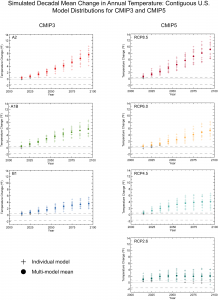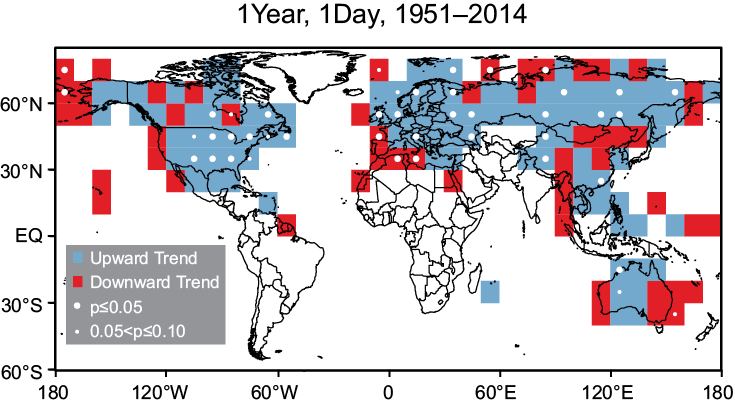Kenneth Kunkel: Highlights 2015
Climate Assessments
 Publication of NOAA Technical Report TR-144 “Regional Surface Climate Conditions in CMIP3 and CMIP5 for the United States: Differences, Similarities, and Implications for the U.S. National Climate Assessment,” comparing CMIP3 and CMIP5 simulations, in support of the National Climate Assessment.
Publication of NOAA Technical Report TR-144 “Regional Surface Climate Conditions in CMIP3 and CMIP5 for the United States: Differences, Similarities, and Implications for the U.S. National Climate Assessment,” comparing CMIP3 and CMIP5 simulations, in support of the National Climate Assessment.- Lead PI on an awarded Strategic Environmental Research and Development Program (SERDP) grant. This is a $2.8 million ($1.53 million to NCSU), five-year project supporting incorporation of effects of climate change into rainfall design values. Work this year included identifying and evaluating trends for extreme precipitation events for selected combinations of average recurrence interval and duration.
- Drafts of 50 states for the NOAA State Summary project have been completed. Twenty-six have been sent out for the formal NOAA anonymous external review process. Express interest exists already in these summaries.
- In support of the upcoming Climate Science Special Report and the Fourth National Climate Assessment, the Localized Constructed Analogs (LOCA) data set was obtained. This is a new statistically-downscaled daily data set based on CMIP5 simulations at 1/16th-degree spatial resolution for the conterminous United States. Computer programs to process these data were developed and an initial set of 23 derived climate variables were calculated.
- Results of Northern Hemisphere analysis of snow trends are generally consistent with simple hypotheses for the likely effects of global warming. In particular, seasonal maximum snow depth has been decreasing in most areas where sufficient data are available to evaluate trends.
- Global analysis of extreme precipitation trends, finding strong upward trends in middle to high latitudes of the Northern Hemisphere; inadequate data availability elsewhere to make general conclusions.

